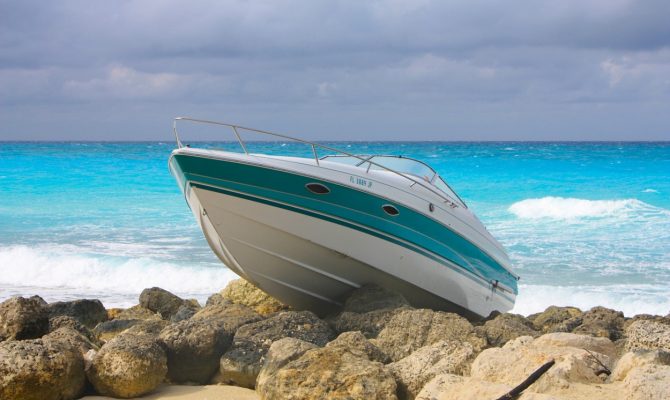Yes, bad things happen. But, here’s where human nature kicks in — the need to make things right again. Our instinct, when we kiss the bottom, is to find good water. When we ground, it’s to get back afloat. This can make an “uh-oh” into a “Mayday.”
Take that delivery skipper, who turned bad seamanship into disaster. Having trashed one prop, shaft and strut, he used the other engine to back off — which he did successfully. Subsequently, the boat filled with water through the chasm left by his ex-starboard running gear. Fortunately for him, the quick response of three towboats and their heavy-duty pumps kept him afloat.
Sure, that’s an extreme example, but with any grounding, from a barely perceptible “thump” to a cliff climb, it’s imperative to immediately stop the boat and look for leaks, paying particular attention to stuffing boxes and seacocks. Often, the problem doesn’t show up immediately, but unless you’re aboard a heavy-keeled trawler or sailboat, the odds are there will be some damage.
Tickling the Bottom
A friend of mine southbound in the Intracoastal Waterway (ICW) ticked the bottom with his port prop. He did the right thing by stopping and immediately checking for damage. Finding none, he continued on. There was, however, a subtle vibration. He figured, correctly, that he had a dinged prop. As he kept running, the vibration got worse and he started taking water from the stern gland. The end result: What could’ve been a prop repair became an expensive replacement of a scored shaft and stuffing box. Basically, if anything appears amiss, get the hook down and holler for a tow.
OK, so you’re hard aground. Are you in a tidal area? If you take the bottom on a falling tide, you’ll be higher and harder aground shortly. After ascertaining that there are no injuries, an anchor needs to be set out into the deeper water — although no immediate attempt should be made to haul off. The deployed anchor will make life easier, for you or the towboat, when the decision is made to refloat.
If the tide is coming in when the boat strikes, you’ll most likely be floating off shortly, which might not be a good thing, as any small leaks will get worse when the water comes up. Go over every dewatering option. Even if you’re not at the point where you need to holler for help, let the Coast Guard know the situation, and keep that commercial tower up to date.
An Ounce of Prevention
The above is moot if we (duh!) just avoid grounding. The first step is to drive the boat. Sound silly? Ask your local towboat captains how many cases they’ve had from boaters fiddling with their new autopilots in skinny water? I work with these pros, and I’m still shocked by how many vessels are “electronically” grounded.
Next on my hit list is the “blind faith in buoys concept.” Some years ago, I found myself flanked by red and green channel markers, thus secure in the knowledge of being mid-channel. True, but I was still hard aground. OK, this was in Florida’s Gulf Intracoastal Waterway (GIWW), where buoys are considered decorative rather than functional; but still, it’s always a good idea to follow an up-to-date navigation chart and check the latest Notices to Mariners.
I can’t blame all my groundings (more than I like to admit) on channels. Being what they are, channels change due to less maintenance or natural features. Have you noticed? For instance, buoys are often set somewhat out of the channel (this is endemic in the GIWW). Therefore, it’s not prudent to work too close to the edge of the channel, especially during periods of low water. As a rule, shoaling occurs at the apex of bends and turns, and often buoyage doesn’t keep up with the shoaling. Drift towards the center — traffic permitting — when negotiating winding waterways. And, of course, reasonable and responsible speeds are a must.
If after every precaution you find yourself aground, determine the tidal situation and where the nearest help is. Know in advance what it will take to dewater your boat. Then, have everybody don a PFD and dig out your checkbook.
Author: Stuart Reininger is a regular contributor to HeartLand Boating magazine



